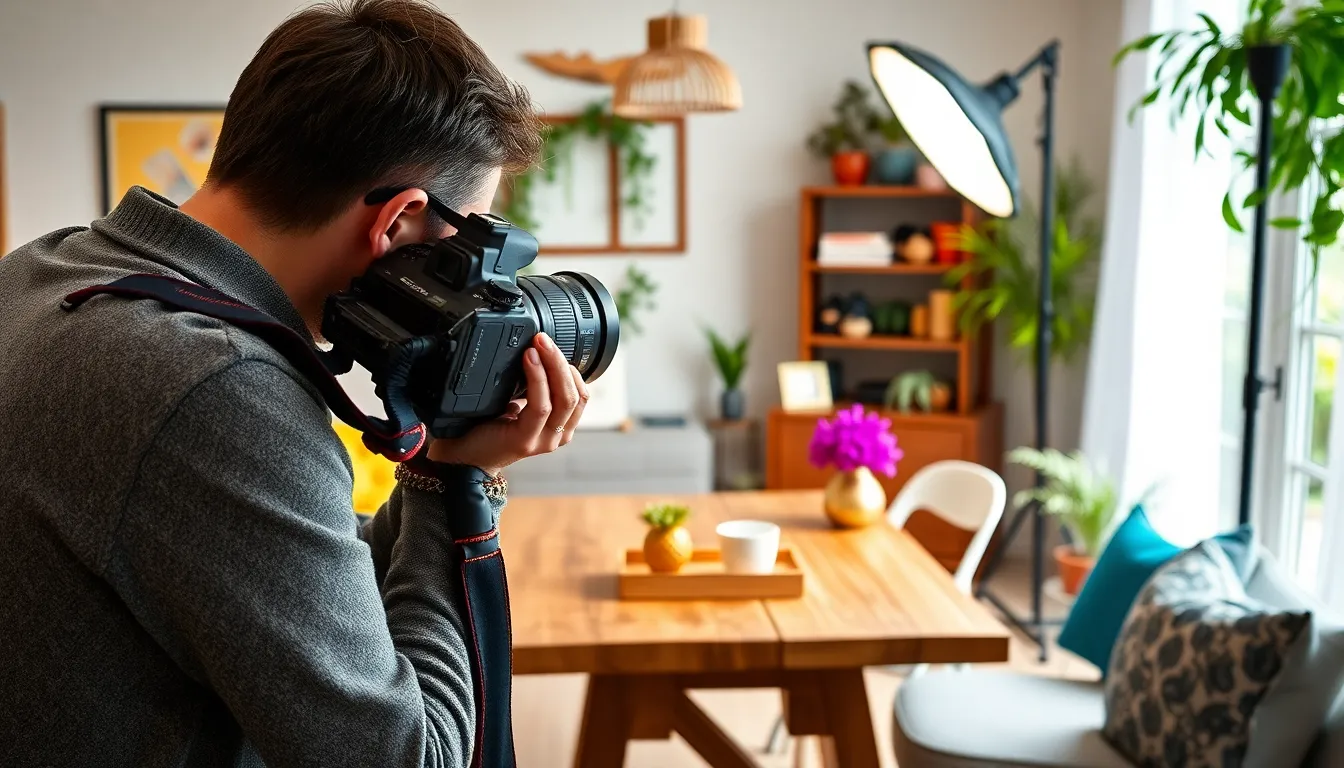Table of Contents
ToggleIn a world where first impressions matter more than ever, lifestyle product photography is the secret sauce that can make or break a brand. It’s not just about snapping pretty pictures; it’s about telling a story that resonates with potential customers. Imagine a cozy living room where a stylish lamp casts a warm glow, or a sun-kissed kitchen showcasing a sleek blender ready to whip up morning smoothies. These images don’t just sell products; they sell dreams.
But let’s face it—taking a great lifestyle photo isn’t as easy as it looks. It requires a keen eye for detail, a dash of creativity, and maybe a sprinkle of luck. Whether you’re a budding entrepreneur or a seasoned marketer, mastering this art can elevate your brand’s appeal. So grab your camera and let’s dive into the world of lifestyle product photography, where every shot is a chance to capture not just a product, but a lifestyle.
Understanding Lifestyle Product Photography
Lifestyle product photography focuses on showcasing products in relatable and appealing contexts. It plays a crucial role in how potential customers perceive a brand, effectively bridging the gap between desire and purchase.
Definition and Importance
Lifestyle product photography captures products in real-life situations, helping customers visualize their use. This approach builds an emotional connection between the product and the audience, sparking interest. Brands gain a competitive edge by telling a story through each image, making their offerings more memorable. Effective lifestyle photography enhances brand perception, conveying authenticity and relatability. Studies show that well-executed visuals increase engagement, ultimately driving sales by connecting with consumer aspirations.
Key Characteristics
Key characteristics of lifestyle product photography include authenticity, context, and emotion. Authenticity stems from using real settings instead of staged environments. Context enriches the narrative, presenting products in everyday situations that resonate with the audience. Emotion evokes feelings through relatable imagery, making products desirable. Cohesion with branding efforts strengthens recognition and trust. High-quality images enhance visual appeal, capturing attention in a crowded marketplace. Attention to detail ensures that colors, lighting, and composition work harmoniously to create impactful visuals.
Equipment Needed for Lifestyle Product Photography

Successful lifestyle product photography relies on the right equipment to capture compelling images. Choosing quality tools can make a significant difference in the outcome.
Cameras and Lenses
Selecting a camera is essential for high-quality imagery. Many photographers prefer DSLRs or mirrorless systems due to their flexibility and performance. Popular choices include Canon EOS R5 and Sony A7 III. Pairing these cameras with versatile lenses enhances the creative possibilities. A 24-70mm lens provides a balance of zoom and aperture options, accommodating various scenarios. Fast prime lenses, like a 50mm f/1.8, excel at creating depth of field, emphasizing products against soft backgrounds. Quality sensors and interchangeable lenses contribute to achieving crisp, vibrant images crucial for engaging lifestyle photography.
Lighting Gear
Effective lighting is vital for evoking mood and emphasizing product details. Natural light serves as an excellent resource, yet it may not always be available. Softboxes and LED panels offer controlled lighting solutions for indoor shoots. The Godox SL60W is a popular choice among photographers for its brightness and flexibility. Using reflectors can direct light more effectively, minimizing shadows and creating a balanced look. Continuous lighting setups allow for real-time adjustments, aiding in achieving the desired effect during shoots. Overall, investing in proper lighting gear leads to capturing stunning, professional-looking lifestyle images.
Setting Up a Lifestyle Product Shoot
Setting up a lifestyle product shoot requires careful planning and attention to detail. The right environment can elevate product imagery significantly.
Choosing the Right Location
Selecting an appropriate location starts with aligning it with the brand’s message. Scenic outdoor settings may enhance a product’s lifestyle appeal, while cozy indoor environments can evoke comfort. Consider accessibility and permits if choosing public spaces. Evaluate lighting conditions since natural light often produces the best results. Urban backdrops may offer vibrant context, while tranquil nature scenes might deliver serenity. Ultimately, the chosen spot should resonate with the target audience and reflect the product’s intended use, creating a visual narrative that engages potential customers.
Props and Backgrounds
Incorporating props and backgrounds adds depth and context to lifestyle imagery. Choose items that complement the featured product without overwhelming it. Household items like books or plants can enhance warmth and relatability. Neutral backgrounds allow products to stand out, while textured surfaces can create visual interest. Ensure that props relate to the product’s function or lifestyle, reinforcing the intended message. Simple elements such as blankets or decorative trays also contribute to the overall aesthetic. Prioritizing quality and style in props ensures that they enhance rather than distract from the product, maintaining focus on the brand’s narrative.
Techniques for Capturing Great Lifestyle Product Photos
Capturing great lifestyle product photos involves mastering several techniques that enhance visual appeal and storytelling.
Composition Tips
Start with the rule of thirds. Position subjects off-center to create balance and draw attention. Use leading lines to guide the viewer’s eye toward the product. Experiment with different angles, such as low or high perspectives, to bring a fresh look. Consider negative space to give the product room to breathe. Incorporate textures and layers to add depth, allowing viewers to feel the setting. Framing the subject with natural elements or props helps to emphasize the product while creating context.
Working with Models
Select models that reflect the brand’s values and resonate with the target audience. Use genuine expressions and interactions to establish a connection. Guide models to interact with the product naturally, showcasing its use in authentic moments. Capturing candid shots often brings a sense of realism to the imagery. Encourage movement to create dynamic compositions and energy in shots. Lastly, maintain open communication with models, ensuring comfort and confidence throughout the shoot for the best results.
Editing and Post-Processing
Editing and post-processing play a vital role in enhancing lifestyle product photography. By refining images, photographers can elevate the visual impact and better connect with their audience.
Software Options
Popular software options include Adobe Lightroom and Photoshop. These tools provide powerful editing capabilities suited for lifestyle photography. Lightroom excels at color correction and batch editing, while Photoshop offers advanced retouching features. Alternative software includes Capture One and GIMP, which also provide effective solutions for photographers. Selecting the right software aligns with the specific needs and desired outcomes for each project.
Essential Editing Techniques
Key editing techniques improve the final appearance of lifestyle product photos. Adjusting brightness and contrast enhances overall image clarity and appeal. Cropping can refine composition, ensuring focus remains on the product. Color correction helps create a cohesive look by adjusting tones to match the setting. Additionally, sharpening details improves product visibility, making it stand out effectively. Utilizing these techniques optimally can significantly boost visual storytelling and create a lasting impression.
Mastering lifestyle product photography can transform a brand’s visual identity. By capturing products in relatable settings, brands can forge emotional connections with their audience. This approach not only enhances brand perception but also drives engagement and sales.
Investing in quality equipment and understanding the nuances of composition and lighting are essential steps toward achieving stunning visuals. Attention to detail during the setup process ensures that each shot resonates with the target audience.
With the right techniques and a focus on authenticity, marketers can create compelling imagery that tells a story. Ultimately, lifestyle product photography is a powerful tool that can elevate a brand’s presence in a competitive marketplace.







